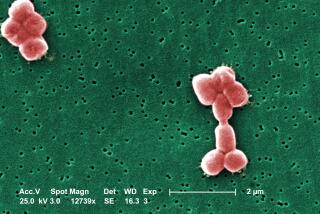Before penicillin, a drug that’s still working wonders
- Share via
SOME wonder drugs have a longer day in the sun than do others. Many people today have never heard of sulfa drugs, but in their time they were considered quite miraculous. And miracles they were indeed, for when they came onto the market in the 1930s, they were the first drugs that could fight systemic bodily infections, even in their most dreaded forms of streptococcus and staphylococcus. Soon, of course, sulfa drugs were overtaken by penicillin and other drugs that we now know as antibiotics, but not before they had saved many lives. Although many of those injured at Pearl Harbor were lost to trauma, none of the badly burned sailors died of infection, thanks to sulfa; Winston Churchill would not have survived to see victory in World War II if his pneumonia had not been cured by it in 1943.
In “The Demon Under the Microscope,” Oregon science and medicine writer Thomas Hager tells the sulfa saga in vivid and compelling detail. Whether he is recounting how the example of the Standard Oil trusts stimulated the formation of giant pharmaceutical conglomerates in Germany as the 20th century began or how prisoners in a Nazi death camp were experimented upon to perfect this new class of drugs, Hager’s story is compelling and horrifying. In boardroom and battlefield, in laboratory and sickroom, he has the ability to zero in on all the inherent drama and color to present an indelible portrait.
Hager is alive to the many ironies that run through the tale he is telling. Here we have not only the axis of corporate profit and service to the benefit of mankind that is a hallmark of the modern pharmaceutical industry, but some historical aspects that take us into very deep water:
“Ironically,” he points out, “the medicine that helped the United States in World War II was discovered in a laboratory in Germany, in the year Hitler came to power, by a corporation whose executives would be put on trial for war crimes at Nuremberg. It would change the way new drugs are developed, approved, and sold. It would transform the way physicians deal with patients. It would usher in the era of antibiotics and lay the foundation for what we now consider modern medicine.
“All of this would result from a combination of corporate strategy, individual idealism, careful planning, lucky breaks, cynicism, heroism, greed, incredibly hard work, and one central, overarching ... idea.
“The story of sulfa’s reign as the world’s leading wonder drug is a short one. It burst onto the global stage in the mid-1930s, created enormous excitement, then all but disappeared just ten years later. Yet in that short time it changed everything.”
Indeed, the urgency of the impetus to perfect a chemotherapeutic agent against infection arose directly from the blood and filth of trench warfare in World War I. Thanks to the manure-rich muddy soil of the front-line battlefields, wounds became horribly infected with all manner of bacteria, often leading to the terrible gas gangrene and the gruesome death it engendered. Appalled by the ghastliness of the wounds they were treating, doctors on both sides were desperate for some way to stem the tide of suffering and death from infection.
Sadly, although sulfa drugs came too late to help combatants in what was supposed to be the war to end all wars, they were on hand when the next world war rolled around, having already saved many civilian lives in the 1930s, including that of Franklin D. Roosevelt Jr.
“By 1943,” Hager notes, “almost every German, American, and British soldier either was carrying sulfa or could get it quickly from the nearest medic. Every American soldier was given a packet or two of powdered sulfa to carry in his first-aid kit, packaged so it could be used with one hand, with instructions to sprinkle it on wounds immediately. Battlefield medical aides doled out powder and pills to anyone threatened with any sort of infection.... Sulfa production on both sides of the Atlantic was increased year after year until it was made by the hundreds of tons.”
By D-day on June 6, 1944, however, large amounts of penicillin had been prepared to treat the allied invasion force, a sign that sulfonamides were already being edged out by their newer, stronger antibiotic cousins.
Yet, as Hager tells us, sulfa drugs have not been entirely eclipsed and continue to be used, even in something as recent as the fight against AIDS-related infections:
“[Sulfa] is still prescribed for everything from urinary tract infections to the pneumocystis pneumonia that can afflict AIDS patients. Sulfa in one form or another today is used for treating middle ear infections in children, for acne, and for a host of other conditions.”
So sulfa is still with us, relevant to our present as well as to our past. Reading Hager’s fascinating book not only makes us grateful for this boon to mankind and all it engendered but even leads the optimist to wonder what role it might still play in our future.
*
Martin Rubin is a critic and the author of “Sarah Gertrude Millin: A South African Life.”






